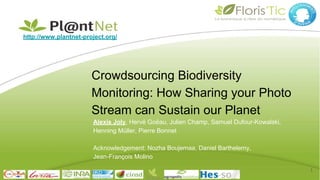
Crowdsourcing Biodiversity Monitoring: How Sharing your Photo Stream can Sustain our Planet
- 1. http://www.plantnet-project.org/ Crowdsourcing Biodiversity Monitoring: How Sharing your Photo Stream can Sustain our Planet 1 Alexis Joly, Hervé Goëau, Julien Champ, Samuel Dufour-Kowalski, Henning Müller, Pierre Bonnet Acknowledgement: Nozha Boujemaa, Daniel Barthelemy, Jean-François Molino
- 2. 2 • Global warming, food crisis and biodiversity erosion • Accurate knowledge of living species distribution and evolution is essential • Ultimate goal: sustainable and global biodiversity monitoring tools – Surveillance of global warming consequences, plant & animal diseases, human activities impact, invasive species propagation • The Taxonomic impediment – Less and less people can identify plants and animals – Less and less nature observers can produce biodiversity data Context
- 3. Pl@ntNet project (launched 2010) Bridging the taxonomic impediment thanks to an innovative crowdsourcing workflow based on automated plant identification
- 4. The positive feedback loop does work ! + + + Pl@ntNet project (launched 2010)
- 5. Pl@ntNet app today2,5 M downloads 14 M sessions 10-50 K users / day 150 Countries 5 Languages FR, EN, ES, IT, PT, DE, AR, ZH, SK
- 6. Pl@ntNet data Validated data = 3% of the queried plant images - 30K collaboratively revised observations per year (TelaBotanica) - Publicly available through international initiatives (GBIF, LifeCLEF) - Validation is a slow and hard process
- 7. Pl@ntNet data Unlabeled data = 97% of the raw query stream - > 1 Million of observations per year (5.1M today) - Not exploited today - A high potential for biodiversity monitoring
- 8. Pl@ntNet mobile search logs
- 9. Species Distribution Modelling from UGC image streams ? Can we predict (real-time and/or long-term) Species Distribution Models directly from Pl@ntNet mobile search logs ? Or from any other UGC image stream ? 9
- 10. Challenges 1. Improve recognition in open-world streams 10
- 11. Recognizing plants in an open world 11 An open-set recognition problem - With 10K’s of known and unknown classes - Highly imbalanced training data We carried out an evaluation within LifeCLEF 2016 - Training set of 1000 known species (113K pictures) - Test set = 8K manually annotated Pl@ntNet queries (half known, half distractors) - Classification Mean Average Precision on a subset of 26 invasive species ?? ? ? ? ? ?
- 12. 1. Improve automatic recognition of plants in open-world streams - Novelty affects all systems, whatever the used rejection method (even supervised) - No rejection method can deal with strong novelty rates → we are still far from being able to monitor biodiversity in Twitter or Snapchat streams ! 12 Recognizing plants in an open world
- 13. Challenges 1. Improve recognition in open-world streams 2. Use geo-location and date 13
- 14. Geo-location and date ? - Not so easy ! - No real success within 5 years of PlantCLEF challenge - Why ? - Plant distributions are not well known (this is actually our objective !) - Habitats are extremely heterogeneous from a species to another one (some plants live everywhere while others live in very specific biotopes) - What can we do ? - Big occurrence data (like GBIF) might help but is biased, heterogeneous and incomplete (no absence data) - Environmental variables might help but heterogeneous, incomplete, noisy, etc. → This will be one of the focus of LifeCLEF 2017
- 15. Challenges 1. Improve recognition in open-world streams 2. Use geo-location and date 3. Use taxonomy 15
- 16. Using taxonomy ? Taxonomy = a hierarchical classification built by botanists for hundreds of years → 600 families > 14K genus > 300K species But, taxonomy is highly heterogeneous and imbalanced → Classical hierarchical classification algorithms can be not be directly used - Some genus with up to 1000 very similar species - But many genus and families include very distinct species - The long tail distribution occurs at each level and in each node Genus Orobanche Genus Bupleurum Family Bupleurum
- 17. Challenges 1. Improve recognition in open-world streams 2. Use geo-location and date 3. Use taxonomy 4. Optimize and boost training data production 17
- 18. Pro-active crowdsourcing Classifier (CNN) Annotators (heterogeneous skills) Tasks selection & assignment ? ? ?
- 19. Training Training 2. Create quizzes by Monte-carlo sampling Beginner Intermediate 1. ConvNet predictions 3. Sort quizzes by difficulty (= success expectation across all workers)
- 20. Identification success rate Experiments: Simpson’s paradox 20 Declared expertise Workers are assigned tasks they have been trained on before !
- 21. Challenges 1. Improve recognition in open-world streams 2. Use geo-location and date 3. Use taxonomy 4. Optimize and boost data validation processes 5. Control bias in Species Distribution Models 21
- 22. 22 Objectif: Estimate the relative abundance Aij of species i in place j supposing Nij ~ Law( Aij , Bij ) Nij : Number of observations of i in j Aij : Abundance of i in j Bij : Bias that might be complex because of the diversity of contributors, the opportunistic property of the observations and the confusions Modeling bias factors ?
- 23. Conclusion: biodiversity informatics needs MM 23 Biodiversity Dimension Biodiversity Conservation Challenge Who? Multimedia research topics Aesthetic Enjoy and love it Everybody IR, Recommendation Diverse Identify and classify Taxonomists Multimodal & Large-scale classification Complex Decipher & model Biologists Multimedia Data analytics Unknown Discover & associate Taxonomists Multimedia Data mining Endangered Define & implement policies Decision makers Visualization, Interactivity Indispensable Use sustainably Everybody Cross-media streams monitoring
- 24. Thank you